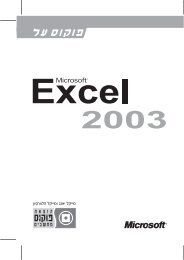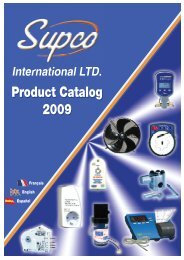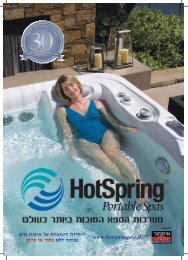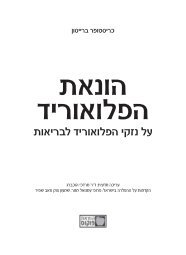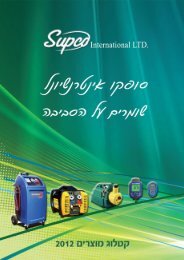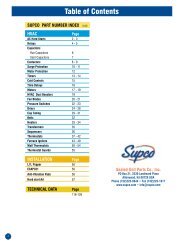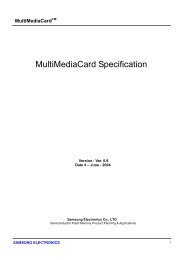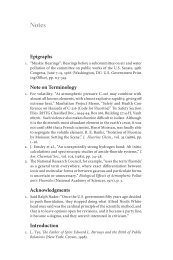Extended Life Coolant - PEHP9557
Extended Life Coolant - PEHP9557
Extended Life Coolant - PEHP9557
Create successful ePaper yourself
Turn your PDF publications into a flip-book with our unique Google optimized e-Paper software.
<strong>Extended</strong> <strong>Life</strong> <strong>Coolant</strong><br />
Better protection for longer life<br />
Bemco (the Caterpillar dealer in Botswana) compared engine<br />
component life using Cat ELC vs. conventional coolant. The liner on<br />
the left – from a Cat 3406 HEUI engine – operated 5,300 hours at the<br />
Gaborone Mine with conventional coolant. It had pitting, which<br />
penetrated the liner wall. The liner on the right from the same<br />
engine ran 10,013 hours with Cat ELC. The coolant side of the liner is<br />
like new.<br />
Injector sleeves from the same Bemco engine showed similar<br />
success for Cat ELC vs. conventional coolant. Note the deposits and<br />
severe pitting after 5,300 hours with conventional coolant (left)<br />
compared with the excellent condition of the injector sleeve with<br />
ELC after 10,013 hours of operation (right).<br />
New chemical technology for long life<br />
Cat <strong>Extended</strong> <strong>Life</strong> <strong>Coolant</strong> (ELC) incorporates an advanced formula<br />
technology with organic additive corrosion inhibitors. Instead of nitrates,<br />
silicates, phosphates, borates, and amines, Cat ELC contains mono- and<br />
dibasic organic acid salts for maximum protection of the six basic metal<br />
alloys—copper, solder, brass, steel, cast iron, and aluminum—found in most<br />
heat transfer systems. Some nitrites and molybdates are added to help protect<br />
the iron components in the cooling system, reducing steel corrosion and<br />
pitting effects.<br />
Cat ELC contains no phosphates or silicates so hard water deposits are<br />
practically eliminated. The low level of total dissolved solids and absence of<br />
silicantes extends water pump seal life.<br />
<strong>Coolant</strong> life in heavy-duty diesel engines is limited by the depletion of<br />
corrosion inhibitors. In conventional coolants, supplemental coolant additives<br />
(SCAs) deplete, so you must add SCAs at every oil change. With Cat ELC,<br />
however, additives deplete very slowly—so you don’t need to add any SCAs.<br />
<strong>Coolant</strong> samples indicate that Cat ELC maintains its nitrite levels up to 20<br />
times better than conventional coolants.<br />
The presence of ethylene glycol in Cat ELC protects cooling systems in cold<br />
climates because it lowers the freezing point. It is also important in all<br />
climates because it raises the coolant boiling temperature.<br />
Caterpillar EC-1 Specification<br />
The world’s most stringent standard for heavy duty coolant<br />
performance is the Caterpillar EC-1 Specification.<br />
This specification requires that the coolant pass extensive tests<br />
including:<br />
• Physical and chemical testing<br />
• Compatibility characteristics with other coolants<br />
• Bench performance testing<br />
• Field testing<br />
The EC-1 tests go far beyond the usual ASTM and other industry<br />
standard tests. Unlike other coolant standards, EC-1 requires field<br />
testing. To qualify as EC-1, a coolant must be operated for a<br />
minimum of 7,000 hours (450,000 km.) in at least six<br />
Caterpillar engines. <strong>Coolant</strong> samples are required every 500 hours<br />
(40,000 km.). The sample results must conform to stringent limits<br />
concerning pH, reserve alkalinity, metallic corrosion, contaminants<br />
and inhibitor concentration.<br />
At the conclusion of the EC-1 testing, each engine is disassembled<br />
and components must meet strict condition requirements. In<br />
particular, the EC-1 test requires no corrosion or pitting, scale or<br />
deposits on the cylinder liners, radiator core, water pump parts,<br />
cylinder head water passages and thermostat housing.




